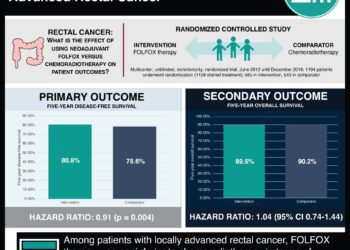Magnetic resonance based preoperative evaluation for perianal fistulas superior to traditional clinical method and improve surgical outcomes [Classics Series]
This study summary is an excerpt from the book 2 Minute Medicine’s The Classics in Medicine: Summaries of the Landmark Trials
1. Preoperative magnetic resonance imaging (MRI) requiring no patient preparation has excellent concordance with surgical findings in perianal fistula and aids in surgical planning.
2. MRI is better than initial surgical exploration in the prediction of patient outcomes.
Original Date of Publication: May 2000
Study Rundown: A perianal fistula is an abnormal connection between a primary opening inside the anal canal to a secondary opening in the perianal skin, often from a draining anorectal abscess. The management of perianal fistulas is a challenging issue in colorectal surgery. Surgery is the primary treatment with the aim of draining local infection, removing the fistulous tract, and protecting sphincter function. In addition to preoperative sphincter function, surgical outcome relies on fistula location, type, and duration. Thus, a thorough understanding of anorectal anatomy is imperative before performing surgery.
Perianal fistulas traditionally are classified by location in relation to the external anal sphincter proposed by Park et al. using only the coronal axis (Table I). Clinical examination based on this classification proved superior to many prior tested imaging techniques, including fistulography, anal endosonography, and computed tomography. However, radiologists at the St. James’s University Hospital recommended a classification that applies Parks surgical classification to MR imaging findings in both the axial and coronal planes (Table II). This provided a more accurate description of the fistula’s relationship to the anatomy of the anal canal and sphincter complex. The St. James’s University Hospital classification thus increases the chance of accurate indication for surgery and avoidance of adverse side effects from inaccurate treatment.
Click to read Morris et al. in Radiographics
Click to read Parks et al. in BJS
In-Depth [classification system based on prospective data]: This prospective study used gradient-echo T1 dynamic contrast material-enhanced MR imaging to demonstrate and classify perianal fistulas into five grades that were based on Parks’s surgical classification. The grades expand on Parks’s classification by classifying anatomy based on the axial and coronal planes. Using both planes, MR imaging clearly shows the anatomical location and course of “high” perianal fistulas that are often misdiagnosed by clinical examination. T2-weighted and short-inversion-time inversion recovery (STIR) show pathologic fistulas, secondary fistulous tracks, and fluid collection. STIR imaging occasionally failed to indicate secondary fistulous tracks and small edematous changes. The St. James’s University Hospital classification system was based on 300 patients with surgically proven fistulas. Fistulas were organized into five grades based on increasing severity: grade 1, simple linear intersphincteric fistula; grade 2, intersphincteric fistula with abscess or secondary tract; grade 3, trans-sphincteric fistula; grade 4, trans-sphincteric fistula with abscess or secondary tract within the ischiorectal fossa; grade 5, supralevator and translevator disease. Patient outcome was predicated on whether further surgery was indicated after MR imaging. Use of this classification indicated a significant correlation with patient outcome (p < 0.001). MR imaging grades 1 and 2 were associated with no indication for surgery and MR imaging grades 3-5 were associated with indication for surgery. The study concluded that any tract or abscess in the ischiorectal fossa is related to a complex fistula indicating the need for surgery (grades 3-5).
Morris J, Spencer JA, Ambrose NS. MR Imaging Classification of Perianal Fistulas and Its Implications for Patient Management. RadioGraphics. 2000 May 1;20(3):623–35.
Parks AG, Gordon PH, Hardcastle JD. A classification of fistula-in-ano. Br J Surg. 1976 Jan 1;63(1):1–12.
©2022 2 Minute Medicine, Inc. All rights reserved. No works may be reproduced without expressed written consent from 2 Minute Medicine, Inc. Inquire about licensing here. No article should be construed as medical advice and is not intended as such by the authors or by 2 Minute Medicine, Inc.







